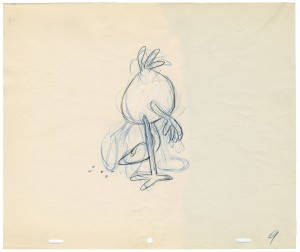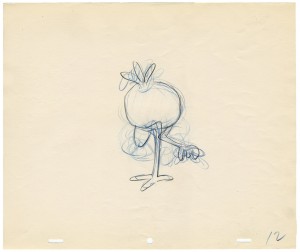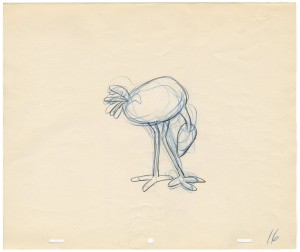repeated posts 15 Feb 2008 08:43 am
Recap Friday: Moonbird
- I had a recent complaint that I’d actually already thought about, so it was one I took seriously. There was a question as to why I feel compelled to post daily, thus rushing away from some of the more important pieces I post. As an example, I give the numerous Bill Peet storyboards that have been loaned to me by John Canemaker. They’re so rich, shouldn’t I keep them up longer? Let me tell you, I’ve considered it.
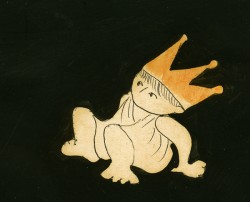 I guess my feeling is that the nature of the “Blog” is that it works more like a diary rather than a website. I do have a site for my own studio’s artwork, and the art stays fairly permanent there.
I guess my feeling is that the nature of the “Blog” is that it works more like a diary rather than a website. I do have a site for my own studio’s artwork, and the art stays fairly permanent there.
The more important pieces I’ve generally split into parts so that it continues for several days so that one is always reminded that it’s there. Of course, there is the “Search” just to the right, so that if you type in “Bill Peet”‘s name, for example, all of those storyboards will pop up.
__________________________________________A drawing from Of Stars and Men
In response to this, I’ve decided, also, to bring
back some of the posts from the past. On Fridays, I’ll pull a rerun to remind you that some gem was posted a year or two ago, and I like it enough to showcase it again.
I hope you don’t mind (let me know if you have any thoughts about this via the comment column). Here, then, is my first repeat. Some drawings – treasures – I love and cherish.
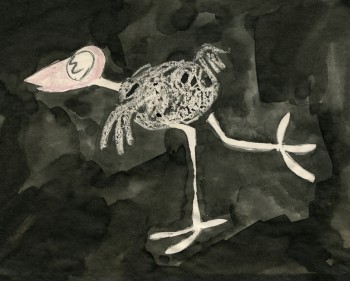 – Moonbird is one of the seminal films of 20th Century animation.
– Moonbird is one of the seminal films of 20th Century animation.
After John Hubley left UPA, where he helped explore the use of 20th Century graphics in animation, he formed a commercial animation company in Los Angeles. Apparently, with this new entity, John did less drawing and more producing. Trying to correct this problem, he closed the LA office and set up in NYC with Faith.
The studio in New York did commercials on a smaller scale. With a Guggenheim Fellowship of $8000, the couple produced a short film, Adventures of an * in 1957 and committed to doing one film a year for themselves. With this film, Hubley picked up where he’d left off at UPA. Exploration of modern art now took on the wildly successful Abstract Expressionists and told a non-verbal story using expressionist art.
The film Tender Game, done in 1958, told another non-verbal story using the song “Tenderly” to illustrate a romance, again, in expressionist art. This film, in some ways, feels like an outgrowth of Hubley’s work on the feature, Finian’s Rainbow.
In 1959, Moonbird took a giant leap forward. The art style borrowed from the expressionists, but used a method of double exposures to layer the characters into the backgrounds. Each animation drawing was painted black outside the border of its lines. Moonbird, the character, was colored with clear wax crayon and painted with black ink. The black resisted where the wax stood and gave a loose scribbled coloring. All of these painted drawings were photographed as double exposures, shot at less than 100%, to combine characters with Bgs.
The soundtrack involved an improvised track of two children, Mark and Ray Hubley, playing. These were recorded in sessions within a recording studio and massively edited down to create the final tracks.
Bobe Cannon animated the film with Ed Smith assisting. Ed inbetweened Bobe’s scenes and animated many others.
A variation of this became the Hubley method. There was usually someone working in the studio who did all inbetweens and animated some lesser scenes. A great way to break into the medium in a big way.
Some extremes by Bobe Cannon are posted below.
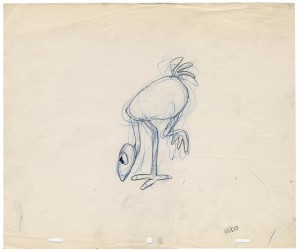
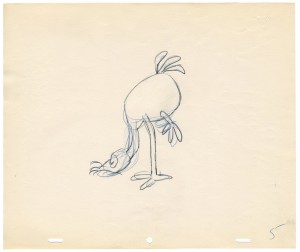
____(Click on any image to enlarge.)
____
____
____
A link to a YouTube version of the movie is available. Not as good as film in a theater, but it’s a way to watch the film.
____
____
